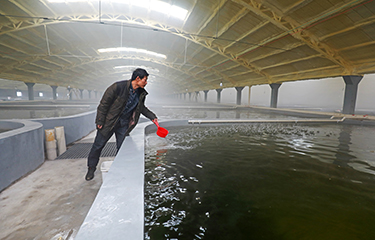Chinese seafood executives are hoping for improvement in 2023 after a difficult 2022, a year during which Covid-related restrictions battered domestic demand.
Lin Xiaowen, general manager at Hainan Eternal Spring Fisheries Co., said business has gotten worse, not better, for her company through 2022.
“Quarter one and quarter two were good for the whole industry, for filleting, feed, and for farmers and exporters. But from the third quarter on, sales have dropped a lot,” Lin said. “Normally, the fourth quarter is a peak season, but now orders from overseas are down a lot. I was told importers say they have larger inventories due to the higher price. As the prices are higher, it’s harder to sell the product, so the inventory remains high.”
Lin said a silver lining of 2022 has been surge in demand from the domestic e-commerce market.
“While overseas remains our largest market, the domestic market is performing better. Every year we see an increase in the domestic market,” Lin told SeafoodSource. “Traditionally we sell through wholesalers, we use middlemen. We also have customers like supermarkets and restaurant chains, but this year we saw a big rise in our sales through e-commerce.”
Fellow Hainan-based tilapia producer Hainan Golden Spring Foods Co.’s sales have decreased 20 percent in 2022 to-date “because of the weak demand worldwide, and especially in the U.S. market,” company export executive Josephine Wang told SeafoodSource.
Looking ahead to 2023, Golden Spring is seeking to make further inroads into China’s domestic market, Wang said.
“We don't really have domestic sales on tilapia, [but] we are trying to make fish balls with fish meat from tilapia for the domestic market. We’re still developing the formula,” Wang said, who said her company is closely watching changing dining patterns in China. “There might be a little increase in tilapia home consumption when it’s [in] ready-to-eat or easy-to-cook [formats]. Some restaurants now also serve tilapia in Sichuanese hot chili flavor, or in Thai salt-baking flavor, or hotpot.”
At Eternal Spring, investment in product development has paid off with pickled and fried fish recipes proving popular with domestic customers. Because of that, Lin is predicting a better year in 2023 on the basis of more entertainment and travel activity in China ginning up demand. Backing that prediction, several investment banks, including Goldman Sachs, have predicted a reopening of the Chinese economy in the early second quarter of 2023 following the easing of China’s restrictive zero-Covid policy.
“The domestic market will be better than 2022, even though this year was better than 2021 for our domestic sales,” Lin said.
Likewise, Lin is projecting stronger U.S. demand in 2023 based on falling tilapia inventories reported by his customers. However, he said the industry’s ability to meet that demand will depend on its ability to maintain current stocking levels after taking a hammering in the latter half of 2022, primarily due to higher feed costs. Feed costs are being driven by a stronger dollar and a weakening yuan, according to Lin, forcing feed companies to pass on higher costs of imported feed inputs.
“Farmers are losing money,” Lin said. “The cost of feed rose every month in the past quarter but the price of fish has fallen due to weak demand. It’s now CNY 4.20 [USD 0.58, EUR 0.58] per 500 grams.”
Pablo Resnik, head of business at international seafood trader Roda International – which has an office in China – said a fear of losing money dented the risk appetite of Chinese seafood importers as they struggled through the depths of the Covid pandemic. However, shipments of Ecuadorian shrimp to China have risen year-on-year thus far in 2022, underscoring the country’s strength as a market. Resnik said the Chinese seafood market is quick to evolve in its adoption of new product formats.
“The evolution of the Chinese market is faster than anything seen in other key markets,” Resnik said. “The Chinese seafood market is always changing, there are always new products being developed. It’s rather different in the European market, where seafood [has been] sold in largely the same way for the past 20 years.”
Bullish on Chinese and global demand for black tiger shrimp, Resnik said Roda is seeking to increase its sales and margins in China by investing in technology at the farm level in supplier nations including Ecuador and India.
“We put a lot of energy into improving technology for farmers and the supply chain. Roda has a full-time innovation manager. We invest, for example, in better feed and feeding systems for hatcheries. It helps to ensure better uniformity of production – this is an issue especially in India,” he said. “Probiotics have very good potential to reduce disease. If [supplier farms] deliver a better product, I will share in the fruits of that. Technology is going to be a game-changer.”
French investment bank Natixis is predicting that China will lift the majority of its Covid-related restrictions in the second quarter of 2023, leading to an upswing in economic growth.
“Domestic consumption, especially local services, are likely to rebound. However, investment sentiment might remain weak throughout the year, especially if the reopening takes place only gradually. In addition, China’s export momentum is likely to subdue because of the increasingly tougher external demand environment,” it said.
Overall, however, China is “bound to decelerate structurally” in coming years, according to Natixis, as it grapples with demographic challenges and a decoupling from major Western economies. Natixis predicted China will see a shift in supply chains away from China to the ASEAN bloc and to India.
Photo courtesy of chinahbzyg/Shutterstock







